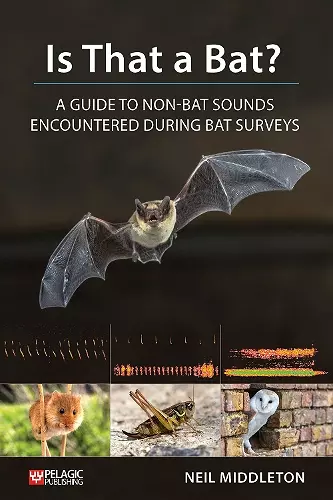Is That a Bat?
A Guide to Non-Bat Sounds Encountered During Bat Surveys
Format:Paperback
Publisher:Pelagic Publishing
Published:6th Jan '20
Should be back in stock very soon

Bat detector surveys are carried out by ecological consultants, researchers, conservationists and hobbyists. Understanding and categorising non-bat sounds in surveys offers the potential of knock-on benefits for informing development projects (e.g. other important records discovered within a site), as well as the possibility of associated conservation benefits. In recent years the number of people carrying out these surveys and recording calls with bat detectors has grown considerably. These surveys often generate vast amounts of audio recordings, resulting in the heavy workload associated with completing the sound analysis and reporting process.
Those carrying out analysis can be distracted, intrigued or delayed owing to the occurrence of recordings that are unfamiliar and not identifiable to them. These recordings can relate to ‘difficult to ID’ bat species, but also, often, sounds not related to bats. This can be especially true when noise triggers such as insects, small mammals or birds look like bat-related noise. Therefore, only knowing what bats sound like is not enough. It is extremely useful to know what other sources of noise look and sound like within the same soundscape. This resource will help bat workers, in whatever environment they are in, to be more confident in recognising, categorising and dismissing other sounds. The book includes a substantial downloadable sound library (.wav format) that readers can listen to by ear or process through sound analysis software.
Is That a Bat? also caters for sounds that are also heard by ear alone, in the field, during the hours of darkness. These scenarios often have bat surveyors intrigued or confused as to what they are listening to. Occasionally, knowing what these sounds are could be important, or at the very least, of interest.
The first chapter caters for the subject overall, including suggestions from the author as to why the subject matter is of value. It also discusses bat-related calls (including social calls) with a view to offering comparisons against the other sources of sound discussed in separate chapters. Continuing through the book, there are chapters covering the following: small mammals; amphibians; insects; birds; electrical/mechanical noise; and other noise/nuisances. Within each chapter there are sub-sections about bat detector recorded sound, sound by ear, as well as advice on techniques and methods to reduce or increase the likelihood...
In fact it is an invaluable read and reference for anyone identifying bats through sound analysis at any level, from beginners to the more experienced. .… This book succeeds brilliantly in encouraging appreciation of the rich and varied world of sound around us. These sounds can sometimes confound our attempts to accurately identify bat species from their calls but at the same time they greatly increase our scope for evaluating and enjoying the biodiversity around us (very timely in the context of current multi-taxa monitoring initiatives). It also makes an important contribution to helping raise standards in the acoustic identification of bats.
-- Philip Briggs, Bat Conservation Trust.. this is the book highlight for me this year.
-- Stuart Newson * BTO News *Very readable book... I expect to use it regularly as a source of reference. I recommend it not just to those members interested in bats and ultrasonics, but to the growing number of us doing nocmig, or using an Audiomoth or other long-term monitoring device.
-- Simon Elliott * Wildlife Sound *… a nice overview of problems a non-expert in bat echolocation research might encounter during a nightly excursion, or when analysing their recordings.
Without a doubt, anyone who intends to record bats in their natural environment, would do well with a copy of this book.
-- Al Milano * batdetecting.blogspot.cISBN: 9781784271978
Dimensions: unknown
Weight: 650g
288 pages